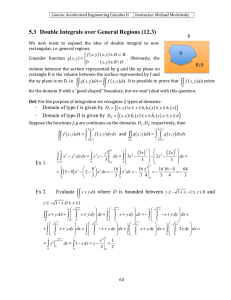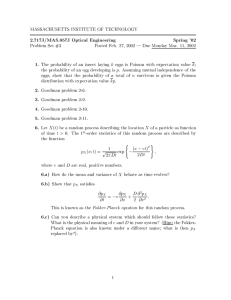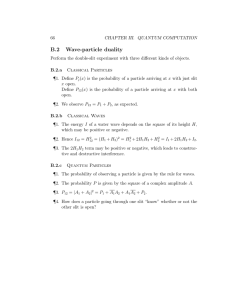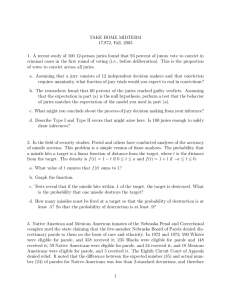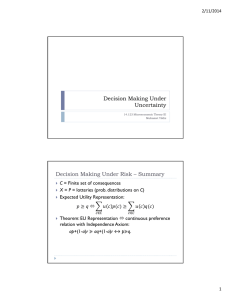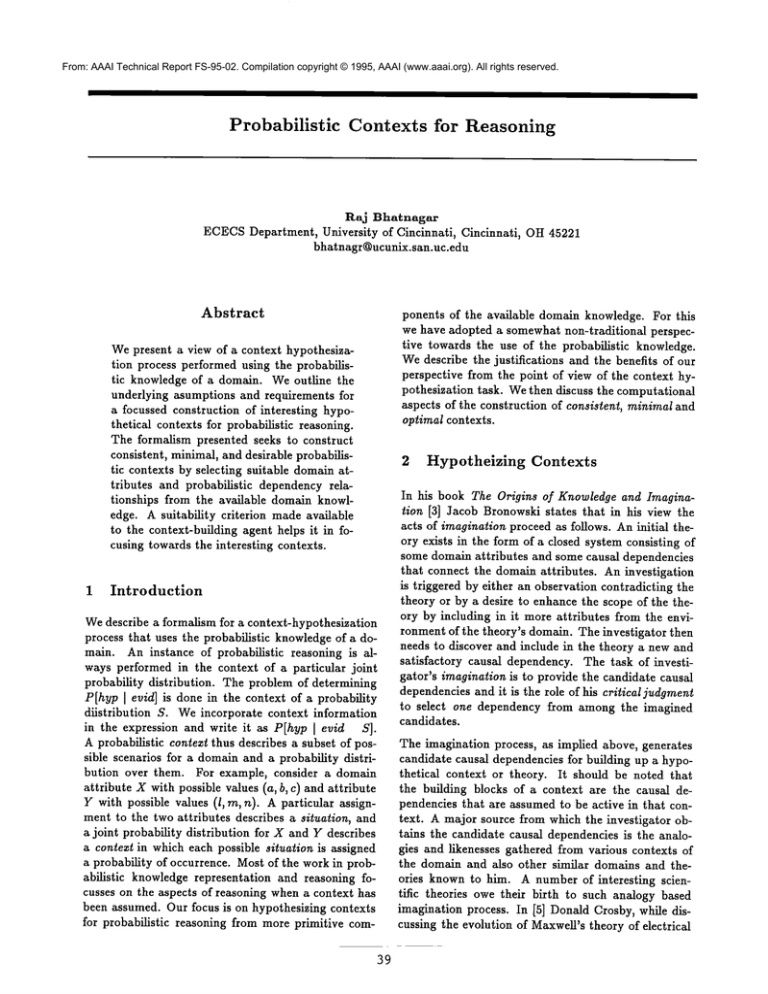
From: AAAI Technical Report FS-95-02. Compilation copyright © 1995, AAAI (www.aaai.org). All rights reserved.
Probabilistic
Contexts for Reasoning
Raj Bhatnagar
ECECSDepartment~ University of Cincinnati~ Cincinnati~ OH45221
bhatnagr @ucunix.san.uc.edu
Abstract
ponents of the available domain knowledge. For this
we have adopted a somewhat non-traditional perspective towards the use of the probabilistic knowledge.
Wedescribe the justifications and the benefits of our
perspective from the point of view of the context hypothesization task. Wethen discuss the computational
aspects of the construction of consistent, minimal and
optimal contexts.
Wepresent a view of a context hypothesization process performed using the probabilistic knowledge of a domain. Weoutline the
underlying asumptions and requirements for
a focussed construction of interesting hypothetical contexts for probabilistic reasoning.
The formalism presented seeks to construct
consistent, minimal, and desirable probabilistic contexts by selecting suitable domainattributes and probabilistic dependency relationships from the available domain knowledge. A suitability criterion made available
to the context-building agent helps it in focusing towards the interesting contexts.
1
2
Introduction
Wedescribe a formalism for a context-hypothesization
process that uses the probabilistic knowledgeof a domain. An instance of probabilistic reasoning is always performed in the context of a particular joint
probability distribution. The problem of determining
P[hyp I evi~ is done in the context of a probability
diistribution
S. Weincorporate context information
in the expression and write it as P[hyp ] evid S].
A probabilistic congezt thus describes a subset of possible scenarios for a domain and a probability distribution over them. For example, consider a domain
attribute X with possible values (a, b, c) and attribute
Y with possible values (l, m, n). A particular assignment to the two attributes describes a situa~ion~ and
a joint probability distribution for X and Y describes
a con~ezL in which each possible situation is assigned
a probability of occurrence. Most of the work in probabilistic knowledge representation and reasoning focusses on the aspects of reasoning when a context has
been assumed. Our focus is on hypothesizing contexts
for probabilistic reasoning from more primitive com-
39
Hypotheizing
Contexts
In his book The Origins of Knowledge and Imagination [3] Jacob Bronowski states that in his view the
acts of imagination proceed as follows. An initial theory exists in the form of a closed system consisting of
some domain attributes and some causal dependencies
that connect the domain attributes. An investigation
is triggered by either an observation contradicting the
theory or by a desire to enhance the scope of the theory by including in it more attributes from the environment of the theory’s domain. The investigator then
needs to discover and include in the theory a new and
satisfactory causal dependency. The task of investigator’s imagination is to provide the candidate causal
dependenciesand it is the role of his critical judgment
to select one dependency from among the imagined
candidates.
The imagination process, as implied above, generates
candidate causal dependencies for building up a hypothetical context or theory. It should be noted that
the building blocks of a context are the causal dependencies that are assumed to be active in that context. A major source from which the investigator obtains the candidate causal dependencies is the analogies and likenesses gathered from various contexts of
the domain and also other similar domains and theories known to him. A number of interesting scientific theories owe their birth to such analogy based
imagination process. In [5] Donald Crosby, while discussing the evolution of Maxwell’stheory of electrical
and magnetic fields, states: "Analogies with fluid flow,
elastic substances, and whirling vortices had helped to
bring the idea of the field into being, but once that
idea had been given a firm mathematical description,
these particular analogies tended to drop into the background,’. This analogy with the mechanics of fluid
flow had helped Maxwell formulate the field theory
which completely replaced the then prevalent and completely different notion of "actions at a distance" for
explaining the effects of what we nowknowas electrical and magnetic fields.
In the discussions by the above quoted authors the focus has been on incrementally correcting or extending
a theory by discovering appropriate causal dependencies amongthe attributes of a domain. Our formalism
generalizes the above incremental notion and seeks to
hypothesize all the causal dependencies for building a
hypothetical context. Since we are using probabilistic
knowledge, we equate the concept of a specific theory with that of a specific joint probability distribution. While seeking to build a hypothetical context
the agent is constrained by the need to remain consistent with the body of observed evidence and is guided
by a wish to make some preferred and desirable inference in the imagined theory. The interestingness of an
imagined context is determined by the following:
1. A set E of constraining events. The occurrence
of these events must be possible in the context of
the hypothesized scenarios.
2. A desired event, d. The probability of occurrence
of the event d conditioned on the occurrence of the
constraining events E in the hypothesized context
S, written by us as P[d[ E (S)], should be very
high/low (as desired by the agent).
The interestingness criterion for focusing the hypothesization process is based on the perception that an
agent is driven by the question: "what are those possible contezts in which the desired event ’d’ would have
a high//low probability of occurrence?", irrespective of
the probability of occurrence of the imagined contezt
itself. As an example, a scientist tries to imagine those
possible scenarios in which his experimental observations are explained and the proposition conjectured by
him has a high probability of being true.
2.1
Computational
Perspective
The hypothesizing agent views probabilistic knowledge
as only a representation mechanism for a particular
kind of domain knowledge. It does not perform traditional probabilistic reasoning with probabilistic knowledge, but uses it to construct descriptions of hypothetical contexts and scenarios. This is done as an exercise
in abduction in which interesting explanations for the
constraining events are sought to be constructed.
2.2
Probabillstlc
Perspective
Knowledge - Traditional
Typically, the observed part of a domain’s knowledge
is available in the form of a numberof databases, each
representing a different contezt of the domain. For example, in the domain of lung-diseases, databases may
be available corresponding to different age groups, different population groups, different specialized disease
classes, and different treatment strategies. Each of
these databases represents a specialized context, reflecting the conditions under which it was recorded.
Let us denote by H = (hl, h2,...hk) the set of all
the relevant attributes
for a domain. We define a
situation-description
(scenario) of a domain to be a
set T of attributes, along with their values such that
T C H and T is non-null. By the term contezt we
refer to a subset of the set of all possible scenarios of
the domain. In a specialized contezt only a subset of
all the possible scenarios are included. In the lungdisease example, each individual database mentioned
above represents a specialized contezt of the domainof
lung diseases, and approximates the joint probability
distribution only for that contezt.
One way in which a database of cases serves as a source
for domainknowledgeis that we can extract from it the
important inter-attribute
dependencies. These dependencies may take the form of conditional probability
functions or the likelihoods used in Bayesian inference.
Let us say that the set P contains sufficient number
of conditional probability functions (dependency relationships) derived from a database having T as its set
of attributes so that the pair < T, P > approximates
the probability distribution reflected by the database.
A different pair < T, P > for each contextual database
represents the probability distribution approximated
by its corresponding database. An example of dependencies learnt from a contextual database S is the
set of probabilities
P[symp~or~ I diseasej (S)].
Bayesian reasoning systems treat these likelihood dependencies as the invariants of the contezt S for performing probabilistic inference. That is, the conditional probability P[symp~orr~ ] diseasej (S)] remains constant in the context S, and is used as a
dependency relation between the probabilities of the
symptom and the disease events.
The problem of compacting a joint probability distribution into the set P of important dependency relationships has been extensively researched and some of
the popular graph based representation methods have
been presented in [4, 6, 7, 9].
In an instance of probabillstic reasoning a set of observed events and dependency relationships are used
to determine the updated posterior probabilities for
the unobserved domain attributes. For example, given
a context S < T, P > and evidence e the posterior
probability for an unobserved attribute-value pair (Hypothesis H) may be computed as:
P[Hle
(S)]=k
¯ P[eIH
(S)]
P[ H (S )].
is maximumamongall possible sets of assignments to
the attributes in set A. Let us say that Ah refers to
that set of assignments which results in the maximum
value for the above probability. Since each possible assignment for the attributes of set A represents a unique
scenario in the context S, the content of the abductive
exercise (in a mannerparallel to Peirce’s formulation)
can be summarized as follows:
(1)
In context S the surprising events of the set E are
observed.
The conditional probabilities used above are contained
as the context invariant dependencies in the P part of
the pair < T, P > for context S. The value P[H (S)]
is the prior probability of occurrence of H in context
S and k is a constant. For different competing hypotheses H the posterior probabilities are computedas
above and then the hypothesis HB~,t with maximum
posterior probability is selected as the most reasonable
hypothesis to believe, given the evidence e.
2.8
Abduction
with Probabilistic
But if assignments Ah were true, E would be a
matter of course.
In the context S there is no other set of assignments for the attributes of set A which is more
likely to occur along with the occurrence of the
observed events contained in set E.
Hence, there is reason to suspect that Ah is true
about the observed situation.
Knowledge
Abductive inference can be understood through the
following simple examplegiven by Peirce in [10].
¯ The surprising fact, C, is observed.
The third statement above says that the Ah selected
is the most probable set of assignments, given the observed evidence.
¯ But if A were true, C would be a matter of course.
¯ Hence, there is reason to suspect that A is true.
Here C is the observed fact and is called ’surprising’
only because it has attracted the attention of the reasoner. The second sentence states the dependency relationship, possibly causal, (and available from the domain knowledge) that the presence of A explains the
presence of C. In the third statement, A is an abductively inferred hypothesis. The content of the inference
is the premise "If A were true, C would be a matter
of course." Given a C, an A which explains the occurrence of C must be discovered by the abductive
reasoner. ManyA’s, each explaining the C, may exist
in the reasoner’s mid and he would have to choose one
from all the possible candidates.
An instance of abductive reasoning in a probabilistic context S < T, P > has been described in [7, 9]
as follows. A set of observed attributes corresponding to attributes E1,E2,...Ek,
contained in set E
where E C T, are given. That is, the instantiations
Ei =eij have been fixed by the observations. The
set A = (T- E) = (A1, A2..., Am) represents all
unobserved attributes of the context under consideration. The objective of the abductive exercise is to find
an assignment for each unobserved attribute Ai such
that:
P[A1= axi,...A,= = a,~,~ [ E1 = eli,...Ek = ekt (S)]
(2)
2.4
Context
Hypothesizatlon
Perspective
One fundamental way in which the hypothesizing
agent’s view of the probabilistic knowledge and reasoning differs from the above described traditional reasoning methods is as follows. The traditional methods
work with a single joint probability distribution. For
a domain D it is assumed that a single database of
cases is available which is used to approximate the
joint probability distribution < H, PD> for the complete domain. A single set of dependencies, the set
PD, characterizes the invariants for the domain.
The hypothesizing agent views the probabilistic knowledge as being structured in one of the following two
ways:
1°
2°
A single database of cases is available for the
whole domain. However, one can define a number
of specialized contez~s for the domainand partition the database according to these contezts. The
database corresponding to the ita partition can be
compacted and represented as < Ti, Pi >. If desired, the smaller contextual distributions can be
recombined to obtain < H, PD > by retaining the
relevant information during partitioning.
No single database for the domainis available but
a number of contextual databases are available in
the domain. The i t~’ of these contextual databases
is represented by < Ti, Pi >. It is not possible
to construct the complete probability distribution
for the domain from these marginal component
contextual databases.
agent considers as models of contextual causal
phenomena that can be used as building blocks
for other building the descriptions of other hypothetical contexts.
In both cases the domain knowledge is represented by
n contextual databases, < T1, P1 >,< T2, P2 > ...
¯ .. < Tn, P,, > where the distribution < ~, Pi > represents the i tn context Si for the domain. It is possible
that an attribute h E H may appear in more than one
context. And in such a case there may exist a dependency of the type P[hla.subset.of.T~ (S,)] in the
set Pi of every context Si that includes h.
The conteztual causal dependencies learnt from individual contexts are reflective of the underlying causal
processes for the context and therefore are viewed
as possible causal building blocks from which other,
possibly not yet encountered, contexts may be constructed. The causal dependencies learnt from a complete domain’s probability distribution can be seen
as weighted accumulations of the causal dependencies learnt from individual contextual databases. This
knowledge, available in the form of contextual invaviant dependencies, is treated as knowledgealone and is
used by abductive reasoning methods other than those
of traditional probabilistic reasoning.
The various Pi’s, therefore, represent the invariant
dependencies for different contezts and are useful for
probabilistic inference only within their respective contexts. If domain’s available causality knowledge can
be used in conjunction with these database then it
is possible to ensure that each dependency P[a [
some.other.attributes
(S)] is such that for every
attribute a the conditioning attributes are only those
that can possibly causally affect the attribute a. The
dependencies in each set Pi can then be seen as the
causal dependencies for the context.
The hypothesizing agent views each conteztual joint
distribution as a source of knowledgefrom which, using the available causal knowledgeof the context, it
can learn the invariant probabilistic causal dependencies for the context. An attributes which appears in a
number of contextual databases may~ therefore, be a
part of one such each dependency in each context in
which it occurs.
2.5
DifFerence
in Perspectives
For an instance of traditional probabilistic inference
the validity of an invariant dependency is limited to
the contezt from which it is derived. The main difference between the imagination task and the traditional
probabilistic inference is the following:
The assumption that we make for the hypothesizing
agent is that the contextual invariants learnt from one
context are valid in other, possibly not yet encountered, situations and contexts of the domain. This assumption is the big leap that we are taking away from
the traditional probabilistic reasoning methods. This
assumption can be considered valid when we view the
contextual invariants as reflecting the causal domainstructural dependencies active during the context of
the situation. Andif a structural dependencyof a domain can manifest itself in one context then the same
should be capable of manifesting itself in other hypothetical contexts of the domain. In our view the
contextual databases can capture the dependencies at
play within each specialized context and a complete
domain domain database represents a statistical
accumulation of the contextual dependencies.
The abduction exercise that the hypothesizing
needs to perform can be stated as follows.
The surprising
observed.
agent
events contained in the set E are
But if the context were to be Sh, represented by
< Th, Ph > then E would be a matter of course.
¯ For traditional
reasoning the only meaningful
knowledge is a probability distribution < T, P >
within which the instances of reasoning are performed.
There is no other context S in which P[d [
E (S)] is greater than what is obtained in the
h.
context S
¯ The hypothesizing agent considers each invariant
causal dependency, learnt from a particular context, as a basic entity of the domain knowledge.
He does not perform the traditional probabilistic
inference in each context. As discussed above, the
hypothesizing agent is free to use likenesses learnt
from one context in other hypothetical contexts.
The context invariant causal dependencies, therefore, are the basic units which the imagination
Hence, there is reason to suspect that Sh is the
most interesting context and the various scenarios obtained from S~ (by makingattribute assignments) are the most interesting scenarios.
The main difference between this abduction formulation and the one described in section 2.3 can be seen
42
in terms of the second and the third statements of
the abduction formulation. The hypothesizing agent
is seeking to hypothesize that context in which interesting inferences can be made and the traditional reasoner is trying to hypothesize the most probable scenario in a given context. The computational problem
of the traditional reasoner’s abduction, as presented
ain [7, 9], is to find the most suitable assignment A
in a given context S. The corresponding problem for
the hypothesizing agent’s abduction task is to find the
most suitable context Sa by selecting an appropriate
subset Th from the set of domain attributes H and an
appropriate subset Pa from the set of all the known
contextual invariant dependencies.
3
The
Dependency
Relation
The hypothesizing agent needs a source from which to
derive candidate causal dependencies for building a hypothetical theory. Webuild this source in the form of
a relation which contains various causal dependencies
learnt from individual contextual databases.
The knowledgecompacted from a joint probability distribution can be represented by the pair K = < H, P >
where H = (hi, h2,...h~} is a finite, non-empty set of
discrete and multi-valued variables, each representing
a domain attribute; and
P_C U {Hi ×H}
where
i=HxHx...xH,
H
i=1
i times
(3)
is a relation with domain(P) = []~i--) {H’} and
range(P) = H. Each element Pi of the dependency relation P represents a particular domain dependency
and also has associated with it the necessary probabilistic knowledge. This probabilistic knowledge may
be either in the form of a joint probability distribution
for all the attributes included in p/, or a conditional
probability function of the range attribute given the
domain attributes.
A joint probability distribution can be completely represented by the pair < H,P >, as discussed above.
However,given a database there is no unique set of dependencies P that characterizes the distribution. The
joint probability distribution of n attributes, by using
the chain rule, can be written as:
P[ht, hz, ...hm] =
P[hl I G1]* P[h2 I Gz] * ... * P[h~-l [ G,~-l] * P[hm]
(4)
where Gi C {hi+l, hi+z,...,
hm). From each conditional probability term above, those conditioning variables can be dropped which are independent of the
conditioned variable. Each resulting product term
43
then represents a dependency of the domain. It is
possible to obtain a different set of dependencies for
the same joint probability distribution by altering the
ordering of the h-attributes. That is, for each ordering
of the h-attributes a different set of dependencies may
be obtained. Weassume that some qualitative knowledge from the domain about the causality ordering of
the attributes is known.Weorder, or partially order,
these attributes in a sequence such that each attribute
is followed by only those that can possibly causally
influence it.
3.0.1
Bayesian
Network
Dependencies
In a Bayesian network we explicitly represent all statistical independencies of the joint distribution. Each
node of the network corresponds to a domain attribute
and all the nodes on which it is directly dependent are
made its parent nodes in the graph. The edges in
the graphs show dependencies between the connected
attributes and the absence of an edge between two attributes means an absence of a direct dependency between them. The dependency between two attributes
connected only by a longer path is mediated by the
nodes on the path.
Each dependency relationship is quantified by a conditional probability function in which an attribute is
conditioned on all those on which it is directly dependent [9] (that is, its parent nodes). Some methods
for learning the Bayesian networks from databases of
cases have been presented in [9].
3.1
Domaln~s Dependency
Relation
For each contextual database of a domain, we can represent the joint probability distribution by the pair
< T, P > where the set P may contain either all the
Chowdependencies [4], or all the Bayesian dependencies or other qualitative dependencies.
Wedefine a relation D for the complete domain, including information from all its contextual databases,
such that
D C U
{Hi×H}
where
Hi =
HxHx...xH,
i times
i=1
(s)
where H is the set of all the attributes in all the
contextual databases, domain(D) = U~i--~ {Hi} and
range(D) = H. This relation has the same character as
the set P of a joint probability distribution. The difference is that D contains all the dependencies learnt
from all the contextual databases or the qualitative
knowledge of the domain and it does not necessarily
constitute a consistent description of a joint probability distribution.
In our view these dependencies represent the causal
dependencies of the domain and are a very useful and
meaningful set of building blocks for the hypothesizing agent. They are also independent entities in the
sense that a particular dependency can be used without worrying about the probabilistic dependence of its
consequent attribute on some other attributes of the
context not included in the dependency. This is because in a Bayesian dependency a consequent node is
probabilistically independent given the antecedent attributes of the dependency.
4
Structure
of
4.1 A SufficientlyLargeContext
A hypothesized
context
thatissufficiently
largein description
should:
Include the attribute d corresponding to the event
of interest.
Include the constraining attributes
the set E.
Include a subset R of the dependency relation D
such that their associated conditional probability
functions define a complete joint probability distribution.
3.
A Context
The task of the hypothesizing agent is to hypothesize a
context Sh such that P[d[B (Sh)] is in accordance
with the interestingness criterion. The interestingness
criterion may seek tMs probability value to be minimum,maximum,or satisfy some specified constraint.
The description of the context Sh consists of the pair
< Th, Ph >, specifying some joint probability distribution. It is an arbitrary, imagined distribution but
must be consistent as the description of a distribution. Hypothesizing a contezt, therefore, is the same
as hypothesizing a relevant, complete and consistently
specified approximation of a probability distribution.
This can be accomplished by selecting an appropriate
set of dependencies from the domain dependency relation D. However, any arbitrary choice for the set
Ph may not be an acceptable description of a context.
The constraints that a hypothesized context Sh must
follow are the following:
1. Sufficiency: A hypothesized context < Th, Ph >
is considered sufficient if all the constraining attributes (E) and the event of interest d are ineluded in the set Tn. The objective of sufficiency
criterion is to ensure that in the imagined contexts
the probability of occurrence for each constraining
event can be computed. Only those hypothesized
contexts are of interest to the hypothesizing agent
in which scenarios with non-zero probabilities for
all the constraining events can be constructed.
Be an Ezplanation for the occurrence of the desired event d and the constraining events E.
In the abduction example given by Peirce in [10], and
discussed in preceding sections, the abductive hypothesis A is considered an explanation of the observed
event C. In this same spirit, we have made precise our
notion of an explanation in [2] and have shown our
hypothesized contexts as explanations of d and E.
4.1.1
Contents
of a Context
A sufficiently large context Sh is one in which the posterior probability P[dl E (SJ’)] and the probabilities P[(ei E E) (Sh)] can be computed and it
an explanation, in the above described sense, of the
constraining and the desired events.
Let us say each element di of D has the form (z, y)
where y is the consequent attribute of di and z is the
set of antecedent attributes of d4. Wedefine the functions conseq(di), antec(di), conseq*(r), and antec*(r)
as follows:
conseq(di) is the attribute y in the pair (z, y) of
d~.
antec(di) is the set of attributes z in the pair (z, y)
of d/.
conseq* (R), where C D,is theset of a ttr ibutes
containing conseq(d~) for each di E R, and contains no other attributes.
2. Consistency: A hypothesized context is considered consistent if it is a complete and consistent
description of a joint probability distribution even though a completely hypothetical joint probability distribution.
3. Minimality: A hypothesized context is considered
minimal if it contains only those attributes and
dependencies that are needed to show the possibility of occurrence of the constraining events and
the high/low probability of the occurrence of the
desired event.
contained in
antec*(R), where R C D, is the set of attributes
containing antec(di) for each di E R, and contains
no other attributes.
A Sufficient description
T, R > such that:
1.
TCH,
ECT,
dET
of a context is the pair <
2.
RCD,
3. d E conseq~(R)
2. each product term and the corresponding dependency in R have exactly the same attributes and
in the same relative positions; and
4. E C conseq*(R)
3. set R includes no other dependencies;
5. There is a path from each ei to either the attribute
d or another constraining attribute ej, and there
is a path from d to at least one ej.
The third and the fourth conditions stated above imply that a hypothesized context must include dependencies that have d and all the membersof E as consequent nodes. That is, we must include in the hypothetical context those dependencies which can be
viewed as the causes for the occurrence of d and the
membersof E. The fifth condition states that in a sufficiently large context each event, in conjunction with
some other event of interest has been explained. This
condition would cause many nodes, other than d and
the constraining events, to be included in set T.
A pair < T, R > that follows the above correspondence
completely and consistently describes some hypothetica] joint probability distribution without either under
or over specifying it.
For somegiven d and E it is possible to select a number
of different subsets R from the set D such that each of
these choices consistently describes a joint probability
distribution. The objective of the hypothesizing agent
is to prefer those contexts in which the probability of
the desired event is maYimum/mlnlmum
(as desired).
4.3
A Consistent
Context
A hypothesized context < T, R > is considered minima] if the following are true:
A sufficiently large pair < T, R > selected as above
would be an acceptable contezt only if the dependencies in R constitute a consistent description of a joint
probability distribution.
4.2
The Minimal
1. Removal of any dependency r E R from the context would disrupt a path between either attribute
d and an attribute ei E E, or between attributes
eiEEandej
EE.
Context
2. Every t E T is included in at least one r E R.
The notion of consistency of a hypothesized contezt
is derived from the perspective of a contezt being the
same as a probability distribution. That is, a context
< T, R > is consistent only if the dependencies in R
completely describe a joint probability distribution for
the attributes in T. This consistency condition ensures
that the resulting context is neither under-specified
nor over-specified. Using the chain rule and deleting
those conditioning attributes which are not a part of
the dependencyrelationship, the joint probability distribution for the attributes of the set T can be written
as:
Pit1, ~2, ...tin] =
P[tl I G1]*P[t2 ] G~.]*...*P[t,~-s I G,,_I]*P[t,~] (6)
where Gi C (~i+l,ti+2,...,tm}.
The similarity between the above expansion and a con~ezt being hypothesized is that each product term on the right hand
side is a dependency in R which helps constitute the
hypothetical contezt. Keeping in mind such an expansion for a probability distribution, we should construct
a context < T, R > by including in R dependencies
from the domain dependency set D such that:
1. there is one and only one dependency in R corresponding to each product term of equation 6;
45
A path is the abductively hypothesized explanation
for all the consequent nodes included in the path. The
above definition of minlmality implies that we don’t
want any such dependencies in the context that are
not playing a role in explaining the occurrence of either the attributes d or a constraining attributes. It
should, however, be noted that a contezt in the above
defined senses of sufficiency, consistency, and mJnlma]ity can be a set of disjoint directed acyclic graphs.
Each Bayesian Networkis a directed acyclic graph [9]
if we assume a direction in each dependency from the
antecedent nodes to the consequent node.
With the constraints on an acceptable Context specified, we now examine the computational framework
for constructing the contexts in which scenarios with
desired probabilities values for the events of interest
can be constructed.
5
Constructing
Preferred
Contexts
The computational task of constructing the optimal
contexts is formulated by us as a state-space search
guided by an admissible heuristic function. The AI
search algorithm A* [8] has been directly employed
in our implementation. Each state is a partially constructed context < t,r > where ~ C T and r C R of
some completely described context < T, R >. In the
start state the set t contains the attribute d and all
the constraining attributes contained in the set E.
perspective of an imagination process and have highlighted the differences between an imagination formalism and a reasoning formalism using the probabilistic
knowledge.
To maintain the minimality and the consistency of the
resulting context description, a dependency d E D can
be added to the set r of a state < t,r > only if the
following hold:
Acknowledgments This research was supported, in
part, by the National Science Foundation Grant Number IRI-9308868. Weare thankful to the reviewers for
their valuable comments.
¯ conseq(d) E (t U antec*(r)), and
¯ conseq(d) (L conseq*(r).
References
[11Raj
Bhatnagar and Laveen N. Kanal. Probabilistic and Structural Knowledgefor Abductive Reasoning. IEEE Transactions on Pattern Analysis
and Machine Intelligence, vol. 15, NO. 3 March,
1993issue.
That is, only that dependency can possibly be added
to a state whose consequent node already exists in the
state and there is no other dependency in the state
with the same consequent node. The successor states
of a search state are all those states that are obtained
by adding one dependency to the parent state. It can
be seen with little reasoning that each possible context description that is consistent and minimal can be
built using the above incremental step of adding one
dependency at a time. Also, all context descriptions
that are built using the above constrained incremental
process are consistent. The minimality is guaranteed
by stopping the incremental steps as soon a sufficiently
large context has been created.
Raj Bhatnagar. Context Hypothesization Using
Probabilistic
Knowledge. To Appear in Fundamenta Informaticae.
[3]Jacob
Bronowski. The Origins of Knowledge and
Imagination, Yale University Press, 1978.
[4]C.
K. Chowand C. N. Liu. Approximating DIScrete Probability Distributions with Dependence
Trees. IEEE Transactions on Information Theory, vol. IT-14, No. 3, May1968
The goal state S for the search algorithm is that completely described context in which each constraining
attribute ei is connected by a path to either the attribute d or another constraining attribute ej. That
is, the the sufficiency requirements for a context as
discussed in section 4.1 are satisfied. The search algorithm yields the best, the second best, etc. hypotheses
until all possible hypothetical contexts have been generated.
6
[5]Donald
A. Crosby and Ron G. Williams. Creative Problem Solving in Physics, Philosophy, and
Painting: Three case Studies, Creativity and the
Imagination edited by Mark Amsler, University
of Delaware Press, 1987, pp 168-214.
[6]S.
L. Lauritzen and D. J. Spiegelhalter, Local
Computations with Probabilities
on Graphical
Structures and their Application to Expert Systems, The Journal of Royal Statistical Society, Series B, vol. 50, No. 2, pp 157-224, 1988.
Conclusion
Intelligent systems have tended to use the probabilistic knowledgeof a domain for probabilistic reasoning
which is performed in the spirit of Bayesian inference.
The task of constructing the conceivable contexts and
scenarios of a domain requires that we moveaway from
the most probable, the most likely, or the least cost focus of the probabilistic inference. Wehave presented
in this paper a formalism for using the probabilistic
knowledge available in a domain, by methods different from those of traditional probabilistic reasoning.
Wehave defined the nature of sufficient, consistent,
and minimal hypothetical contexts that can be conceived by an hypothesizing agent and have briefly outlined an AI search based computational formalism for
arriving at the interesting imagined hypotheses. We
have presented justifications of this formalismfrom the
[7]Richard
E. Neapolitan Probabilistic Reasoning in
Ezpert Systems, John Wiley and Sons, Inc. 1990.
Is]Ntis Nilsson. Principles
of Artificial Intelligence,
Tioga Press, 1980.
[9]J.
Pearl. Probabilistic Reasoning in Ezpert Systems: Networks of Plausible Inference. Morgan
Kaufmann, San Mateo, CA, 1988.
[10] Charles S. Peirce. The Philosophy of Peirce - Selected Writings, Edited by 3ustus Buckler, Harcourt, Brace and Company, 1940.
46

